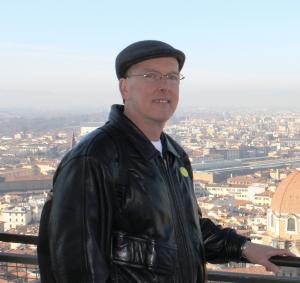Resources

As a seminarian in Louisville, Kentucky, I was challenged to discern what kind of ministerial vocation I wanted to pursue. I felt my “calling” was to teach, but even teaching, if done with care and concern for the students, could in some ways be “ministerial.” My greater concern was with what model my teaching or “ministry” would follow. Would I be the sage on the stage (or in the pulpit), imparting words of wisdom and knowledge? Or would it be more organic, flowing from the relationships I developed with my class or my congregation? Eventually, the model I chose was one I found in the gospel of Mark when Jesus encounters the blind man Bartimaeus (Mark 10:46-52). Jesus comes upon this blind man, one of the countless beggars asking for handouts at the gates of the city, and he asks him, “What do you want me to do for you?” Are your serious, Jesus? It is obvious to everyone there what Bartimaeus needs. He’s blind, and because of his blindness he has no way of making a living and must beg to survive. He needs to be cured of his blindness! But instead of assuming Bartimaeus’s need and helping him based on that assumption, Jesus, by asking the question, gives Bartimaeus a voice in the form and direction Jesus’s ministry (or teaching?) will take. And this experience, this opportunity, so empowers Bartimaeus that Jesus proclaims, “your faith has healed you.” This model has been crucial for me ever since, never more importantly than when I was a student chaplain at University Hospital in Louisville. One evening I was on call in the emergency room, my favorite place to work, when I received word from the delivery room that a Seventh Day Adventist woman who had just delivered a stillborn child requested that a chaplain come and baptize her child. I was the only chaplain around, but at the time I was a Baptist. You may or may not know that Baptists don’t believe in infant baptism, only in believer’s baptism. (Baptists still find a way to welcome children into the community—they just call it a baby dedication.) Moreover, I had never done a baptism before. How could I in good conscience baptize this infant? When I arrived in the delivery room, I explained my dilemma to the nursing staff, who, despite listening sympathetically, dressed me in a surgical gown and provided me with a basin of water. Apparently, they had done this before, and they needed the delivery room again for another delivery. Nurses are amazing at finding ways to get you to do the right thing even when you don’t want to. Upon entering the room, I saw a tired African American teenager lying on a birthing table lovingly caressing a fully formed, beautiful but lifeless, little girl. The woman’s older brother was there mumbling something about it probably being God’s will because the child was conceived illegitimately, which was clearly causing emotional pain for the girl. What is it with self-righteous older brothers? Why do they think they can speak for God words of judgment and condemnation to their siblings who are experiencing grief and despair (Luke 15:29-30)? Whispering to the nurse, I asked her to find a way to get the brother out of the room which she did with great skill and grace. Thankful for his departure, I came to the young woman’s side anxious about what to say, unsure of what to do, angry at her brother’s rantings. Yet as I looked into this woman’s tearful and soulful eyes, all I could think of was to ask, “What do you want me to do for you?” She looked at me and asked me to baptize her child so that her spirit and her daughter’s spirit could be at peace with God. Full of uncertainty and doubt about what I was doing, I took the child in my arms, asked what her name was, dipped my thumb and forefinger into the basin of water, and anointed her head with the water saying, “I baptize you in the name of the Creator, Christ, and Comforter.” Then I placed the child back into her mother’s arms. Baptists say there is nothing sacramental about the ritual of baptism; no saving grace comes from it. Perhaps. In that ritual act in that delivery room, however, I experienced the presence of God in a way I have seldom since, an experience I can only describe as grace. As I looked at the woman, I could see that she had experienced it as well. The peace the woman requested had come to her, hopefully to her daughter, and, unexpectedly, to me. And this experience enabled me to proclaim confidently to this young woman, “your faith has made you, made us, well.” Through this and countless other experiences, I have learned that if ministry or teaching is about enabling others to find wholeness, whether intellectual, social, or spiritual, then that work will best be accomplished when we take seriously the voice of those with whom we work. When we intentionally ask the blind, the homeless, our students, “What do you want me to do for you?” and respectfully incorporate their responses into our work, we affirm their worth and dignity, and empower them to have faith in themselves, in us, and perhaps in their God. And this faithfulness will go a long way to meeting human need and enabling all of us to become whole.

The idea of Art Theology raises the question(s): what is art and what is theology? We live within this incredible moment of decolonization where people are interrogating the ideas of the academy and its gatekeepers. Inspired by the decolonizing work so many are engaged in, Art Theology seeks to create something new. There are wonderful conversations going on. Beyond what art is, who decides what “great art” is? Who is a “great artist”? Where should “great art” be held? And who is privileged to view it? The old gatekeepers of “art” were many of the same gatekeepers of the academy. The academy, built by free white men who created the method of research. We teach college students to write research papers that argue a thesis. If they want to succeed in the academy, they have to learn to write this way: arguing judging defining using propositions being technical always reaching for “objective truth” I wanted a method built on and towards connection rather than argument. I have learned that the first step is to remove judgement. Get rid of the word great and tell me what it is to make art. I often engage my students in peer reviews, whether they are writing a research paper or making art. Before they meet with their partners, I ask them to write out their feedback by first summarizing the piece, then describing strengths of the piece, and finally offering questions or suggestion, (they only offer suggestions if they are sure they have understood their peer's intent in the piece). The thing they have to be sure of—and that I review in their feedback before they share it with each other—is that they remove all judgement. They struggle at first wanting to write, “I like your conclusion” or “This is great…” I invite them to remove like and great and say something more. This encourages them to go back and look more closely, read more closely, in order to reimagine the sentence to something like: “Your thesis is so clear from the very beginning of your paper through to the end. You keep returning to the thesis like a spiral throughout, it is this clear throughline reaching into the conclusion. When you restate your thesis in your conclusion it really it holds the paper in a very satisfying way.” Removing judgement not only helps them read more closely, it removes the fear that they often feel going into peer review. Once judgement is removed, we are free to make new things. Our focus shifts toward making art in order to engage in visual-thinking that creates new theological insights and understandings. What is theology really? The exploration of ideas and understandings of God? Knowledge of God? But, I do not just know things in my mind—I know them in my body. I also know them through making. Art Theology uses visual-thinking, seeing, and making to explore questions and ideas about God. In the abstracting grace series I created for the Wabash Center, I made my way into new questions and ideas about grace through painting and poetry. For example, in making, Is it like air? as I painted I somatically realized I had been unconsciously carrying an idea that grace was arbitrarily given. I didn’t know why Mary had been “full of grace” and I wasn’t. I reviewed what the academy had taught me about grace and saw that it was all bound up with sin and the idea of gift. Which made me wonder, if it is a gift how is it given? As I dipped my paintbrush into the white acrylic and made a swooping line I thought, maybe it is like air…all around us, all the time, and it is us who decide how we breathe it in. This insight had me revisiting Duns Scotus’ idea of the will and how it is the will that makes us human, not our intellect. Scotus said our will is where our capacity to love resides. This is the greatest gift we have been given, and it is all around us. We choose how mindfully we breathe. Through making art theology, a new rich understanding of grace came into being. A new understanding that discursive reasoning alone could not, and had not, given me.



